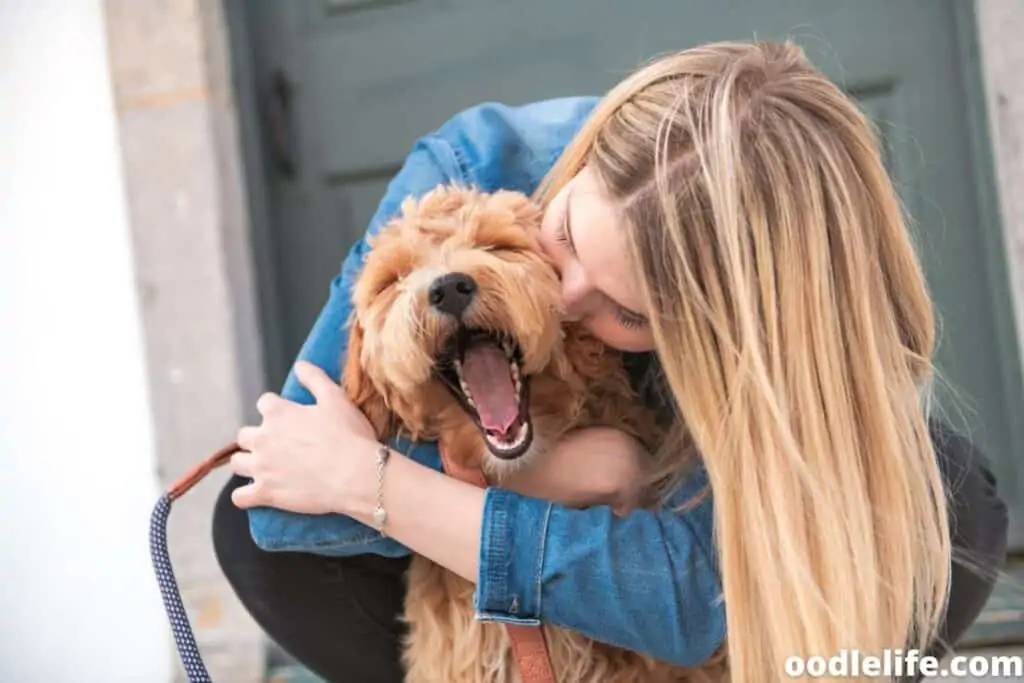F1 vs F2 Labradoodle (Explained)
Labradoodles are one of the most sought-after dog breeds. Aside from looking like walking teddy bears, they also have the easy-going nature of a labrador retriever and the intelligence of a poodle.

They’re terrific for allergies, too, as their coats don’t produce as much dander as other dog breeds.
Like any dog, though, the Labradoodle has its variations regarding the breed. The two main types of Labradoodle are the F1 and the F2.
If you’re looking to find which Labradoodle is best for you and your family, read on! We’ll explain the differences, similarities, and concerns with each breed.
What are F1 and F2 Labradoodles?
Simply put, the F1 has purebred parents – meaning that the mother and father were both purebred poodle or labrador retrievers.
An F2 Labradoodle comes from two Labradoodles. Some breeders prefer F1 Labradoodles because there’s more genetic variation.
The “F” in F1 and F2 represents the term filial. F1 is the first generation of offspring born from two different species of parents.
F2 is the following generation – so the Labradoodle was born from two F1 Labradoodles.

The F1 Labradoodle
The F1 Labradoodle is the best of both worlds when it comes to dog breeds. Both parents are among the most intelligent dog breeds, and they’re known as family-friendly dogs.
Since they have a more stagnant genetic make-up, the F1 Labradoodle is often healthier than the F2. Without too much genetic variation, a life-threatening health condition is less likely.
Personality
F1 Labradoodles have desirable dispositions! Some of their most common traits are:
- Adaptability – great if you’re a growing family
- Affectionate
- Relatively easy to train
Labradoodles are playful – they can be a bit overwhelming if your children are small. Just keep an eye on them early on to make sure your Labradoodle isn’t too aggressively friendly.
F1 Labradoodles, like the labrador retriever, aim to please. If you want a loyal, trustworthy dog, an F1 Labradoodle is perfect for you.

Grooming and Coat
At first glance, the F1 Labradoodle can look like a burden to groom. They aren’t as bad as you’d think, we promise, as long as you keep up with grooming and brush a few times a week.
F1 Labradoodles, if they inherit their labrador parent’s fur, will have a straighter coat that sheds more – so more brushing and maintenance. The typical wiry or curly Labradoodle coat does not require as much grooming as the straight coat.
F1 Labradoodles have an undercoat, like labrador retrievers. Proper brushing gets rid of the dead undercoat fur and allows a healthy coat to grow. If you don’t brush the undercoat regularly, your F1 Labradoodle can get mats in their hair – which may require removal by your vet.
Some tips for brushing your F1 Labradoodle:
- Start brushing every day, so the dog gets used to grooming
- Shaving does not result in less shedding – it’s better to brush
- F1 Labradoodles tend to have the highest level of lab genes – so more shedding
The curly-haired Labradoodle is the most popular and is the least high-maintenance.

Health Problems
As mentioned above, F1 Labradoodles do not have as many health issues as F2 breeds because of their lack of genetic variation.
F1 Labradoodles aren’t in the clear completely, though. They have shared issues with the labrador retriever and poodle breeds.
The labrador side contributes to health problems such as hip dysplasia and several abnormal eye conditions.
The poodle side is prone to Addison’s Disease, an illness that attacks the pituitary gland and requires lifelong medication. F1 Labradoodles can inherit a bleeding disorder from poodles as well, called Von Willebrand’s disease.
Both parents can pass down allergies, chronic ear infections, epilepsy, and gastrointestinal problems.

F1B
From the F1 Labradoodle comes the F1B, a descendant. The F1B is back-bred with a poodle, so its genes are 75% poodle and 25% labrador retriever.
The F1B is the preferred option if you want a curlier, more poodle-like coat.

The F2 Labradoodle
The F2 Labradoodle has two F1 Labradoodle parents. The F2 breed has all of the best traits of the F1 and more. Funny, charismatic, and excellent companions, the F2 Labradoodle is man’s best friend.
The F2 Labradoodle doesn’t stray too far from the F1 – but there are a few differences in coat, maintenance, and personality.
Personality
Some vets say that F2 Labradoodles are, for lack of a better term, wild. If the F2 Labradoodle has poodle-heavy genes, a high-energy dog is likely.
Wild personalities are pretty rare for Labradoodles, but make sure when you’re checking out F2 breeds that they don’t growl or confront you aggressively. Those are red flags for future behavior issues.
You may want a higher-energy dog, especially if you want a running or hiking companion! Just be aware that some Labradoodles are too much to handle for some owners.
Most of the time, F2 Labradoodles are as loyal and cuddly as their F1 counterparts.

Maintenance and Coat
F2 Labradoodles are more likely to have the classic curly coat of Labradoodles. And, allergy sufferers, you’ll be glad to know that the further down the generational line, the less dander and allergens Labradoodles have.
An F2 Labradoodle has way less of a chance of giving you an allergic reaction than an F1 Labradoodle.
Their coats still have a chance of being straight, so if you want strictly curly fur, try to find a puppy with one F1b Labradoodle parent and an F1 parent – that way, the wiry-haired poodle genes are more dominant.
There are a few tools you should purchase if you have a curly-haired F2 Labradoodle. These include:
- Slicker brush for getting rid of mats
- Wide-tooth comb
- Detangling spray to keep your dog comfortable
A longer, curlier coat means daily (or almost daily) maintenance, so ensure that’s something you’re willing to do before investing in an F2 Labradoodle.

Health Concerns
The F2 Labradoodle is, unfortunately, much more unpredictable health-wise than F1 Labradoodles.
The risk of health concerns goes back to genes and which traits are dominant/recessive. If an F2 comes from healthy F1 parents, they should not have too many issues.
But, if the breeding line is more complex and back-crossing occurs, more health problems could occur.
A few conditions to watch out for are below.

Sebaceous Adenitis (SA)
SA is a skin condition that occurs in poodles. The sebaceous filaments in the skin become inflamed, leading to further skin problems. SA can cause:
- Excessive dandruff
- Musty odor
- Hair loss
SA varies in severity and can occur in F1 Labradoodles. The disease shows up more often in F2 breeds.
Lymphoma
Lymphoma is arguably the worst condition on this list. It’s a cancer of the lymph system in the body and causes problems like swollen glands on the neck, lethargy, difficulty breathing, and digestive upset.
Fortunately, Lymphoma is the most responsive cancer to chemotherapy, so don’t let this deter you from adopting or owning an F2 Labradoodle entirely.
F2 Labradoodle Final Thoughts
F2 Labradoodles are the less predictable Labradoodle when it comes to breeding. They are still active, loving dogs that, if from a reputable breeder, make great companions.
An F2 Labradoodle is the way to go if you want the traditional Labradoodle look.

Conclusion and Takeaways
Many breeders and Labradoodle owners participate in the F1 vs. F2 Labradoodle debate, but if you’re interested in adopting a Labradoodle, you shouldn’t base your decision solely on the genetic line.
The F2 Labradoodle, although more random in genetics, is not that different from the F1. Make sure you go to a reputable breeder and an ethical breeder to ensure your Labradoodles parents get screened for common diseases and behavioral problems. (This is less possible if you rescue a Labradoodle)
Labradoodles, both F1 and F2, are active, nature-loving dogs that are ready to join you on your next adventure.